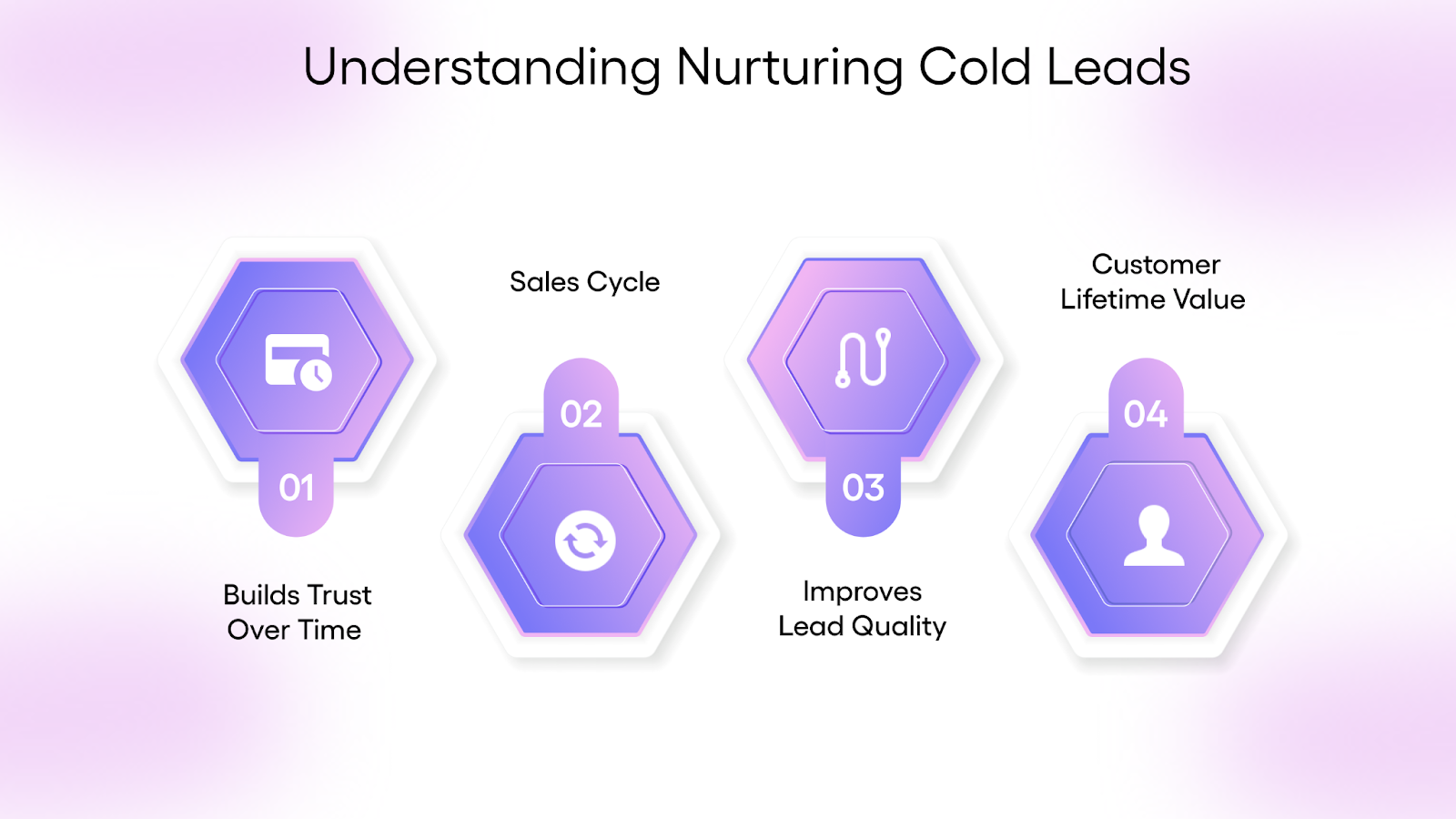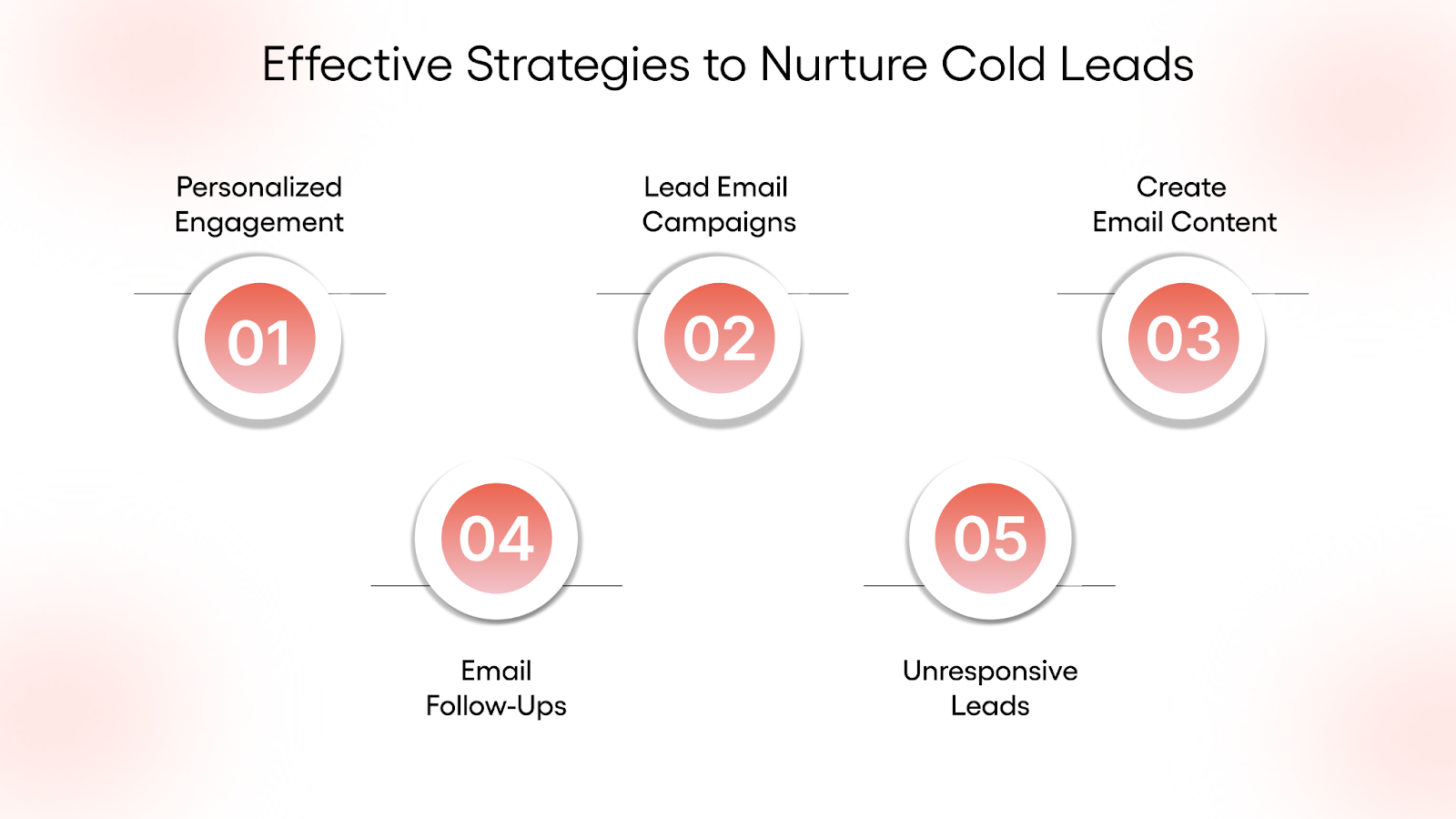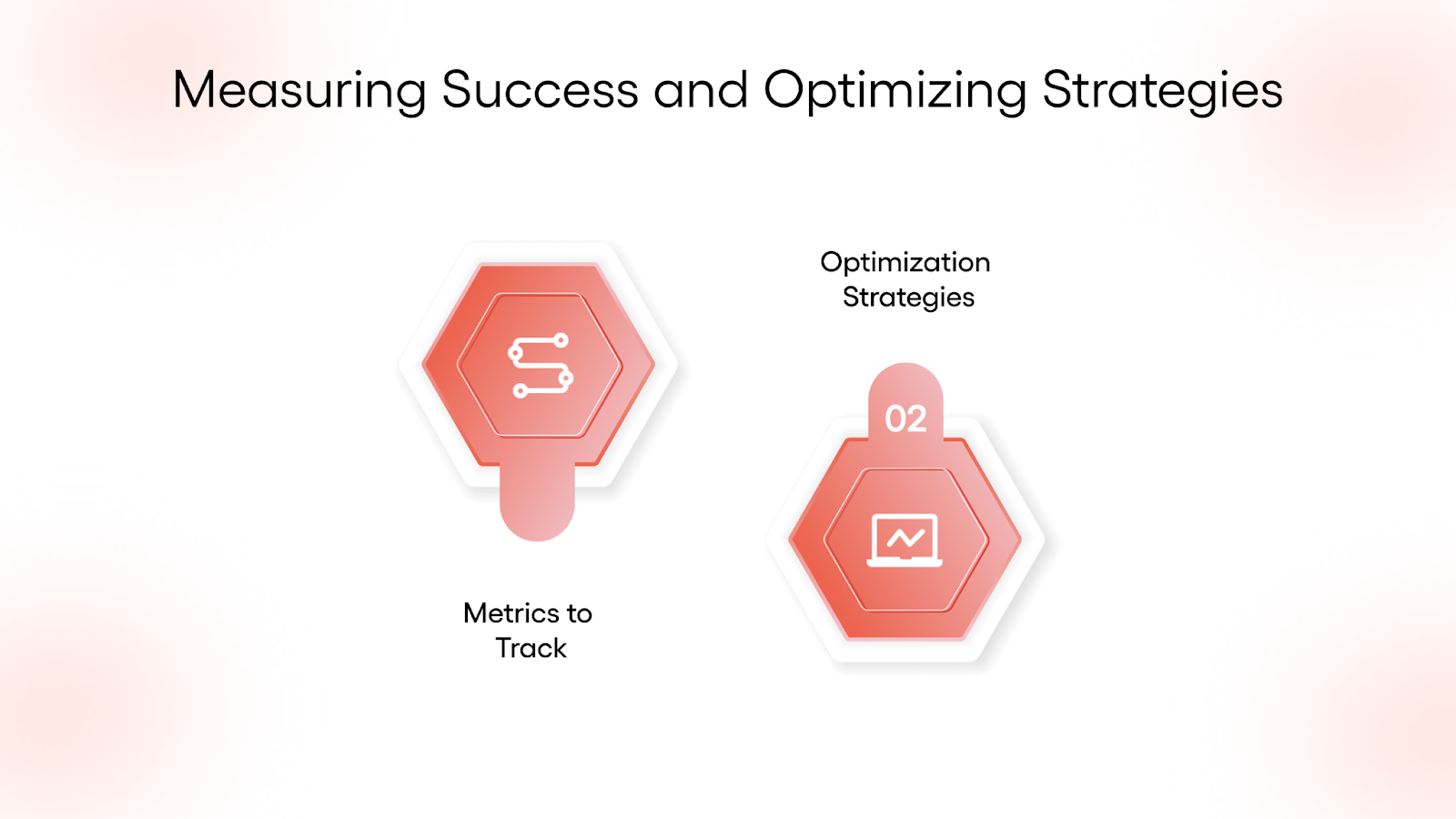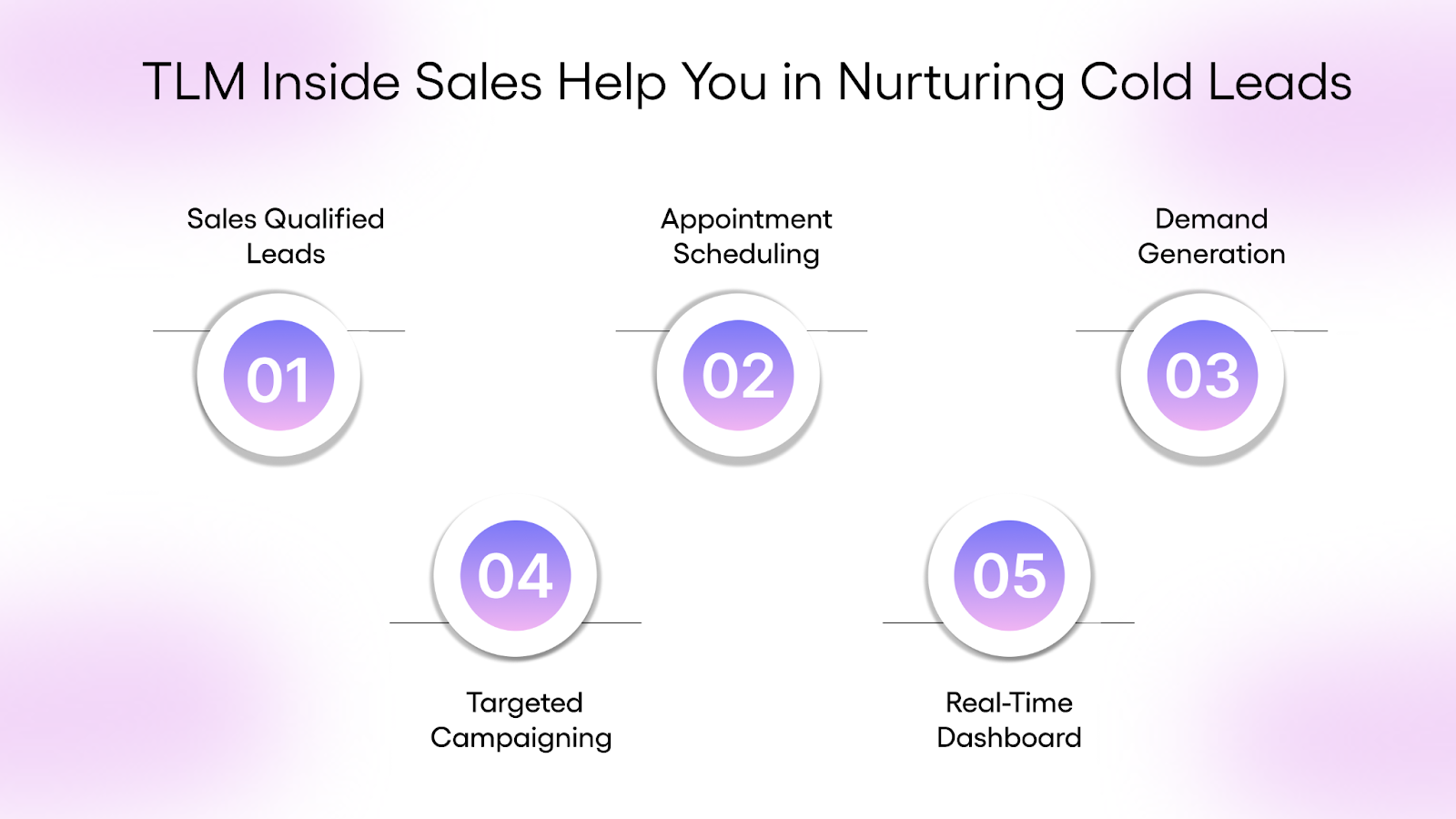
Effective Strategies to Nurture Cold Leads

Every lead holds potential. The key is how you nurture it. While it’s true that around 80 percent of new leads never convert into sales, this often happens because they do not receive timely or personalized follow-ups. Over time, these leads go cold due to shifting priorities or a lack of alignment with current offerings.
The good news is that cold leads are not lost opportunities. With the right approach, they can turn into valuable prospects. Effective nurturing through personalized outreach, consistent communication, and relevant content can reignite interest and build trust.
In this blog, we will explore proven strategies to effectively nurture cold leads, turning them into engaged prospects and, ultimately, loyal customers.
TL;DR
- Cold leads are not lost opportunities; nurturing them through personalized follow-ups, targeted email campaigns, and relevant content can reignite interest.
- Segment your audience based on industry, role, and needs to send tailored messages that resonate.
- Effective email campaigns should start with re-engagement, followed by value-driven content and gentle CTAs.
- Share educational content to position your brand as a trusted authority and address pain points.
- Use follow-up cadences to maintain contact without overwhelming leads, adjusting messaging to keep engagement high.
- For re-engagement, refresh your value proposition and use subject line tests to capture attention.
- Track KPIs like open rates, CTR, and conversion rates to measure success and optimize your strategies.
What Is a Cold Lead?
A cold lead is a potential customer who initially showed interest but has stopped engaging. They may have interacted with your emails, visited your website, or filled out a form, but after that, communication goes silent. Follow-up emails go unanswered, and there’s no further interaction.
Why Do Leads Turn Cold?
Leads often turn cold when interest fades or communication lacks relevance. Common reasons include:
- No Immediate Need – The timing isn't right for your service.
- Budget Constraints – Financial limitations delay decision-making.
- Low Awareness – The prospect may not fully understand your value.
- Missed Follow-Ups – Inconsistent communication causes drop-off.
Understanding these factors helps you refine your outreach, tailor your messaging, and focus efforts on the right prospects. With the right strategies, even cold leads can be brought back into the pipeline and converted into meaningful opportunities.
Understanding Nurturing Cold Leads and Why It's Important

In B2B sectors like managed services, recruitment, and technology, leads often stall due to long buying cycles, shifting priorities, or poor timing. These cold leads may slow down your sales pipeline. However, with the right nurturing strategy, they can be reactivated into valuable opportunities.
Lead nurturing focuses on building trust, offering timely value, and moving prospects toward sales readiness, especially when decisions take time and involve multiple stakeholders.
Here’s why nurturing cold leads is critical for growth:
1. Builds Trust Over Time
Most cold leads aren’t ready to buy; they’re still exploring. Sharing relevant insights through targeted email marketing and industry-driven case studies helps establish credibility. This is especially valuable for MSPs and tech firms, where trust directly impacts conversion.
2. Shortens the Sales Cycle
Engaged leads make faster decisions. Nurturing with personalized content and timely appointment setting can uncover hidden intent and move leads forward efficiently. This improves both pipeline velocity and conversion consistency.
3. Improves Lead Quality
As you segment and nurture cold leads, their responses help qualify them further. This supports your sales team in focusing on high-potential prospects, leading to more targeted Sales Qualified Leads.
4. Maximizes Customer Lifetime Value
Nurturing doesn’t stop at the first sale. Keeping in touch with personalized updates and support opens doors to repeat business, cross-sell opportunities, and referrals, resulting in stronger retention and higher monthly recurring revenue (MRR).
Also read: Why Email Marketing Is a More Effective Strategy Than Cold Calling.
Nurturing cold leads means building relationships and guiding buyers. For B2B SMEs, it improves conversions and drives growth. Let’s explore how using the right strategies turns leads into loyal customers.
Effective Strategies to Nurture Cold Leads and Boost Sales Pipeline

Turning cold leads into loyal customers requires a targeted approach that engages prospects, builds trust, and guides them smoothly through the sales funnel.
Here are the best strategies on how to nurture cold leads:
1. Segment Your Audience for Personalized Engagement
Personalization begins with segmentation. By grouping leads based on industry, role, and needs, you deliver highly relevant messages that resonate.
For example, Peer Team provides programs to MSPs across the U.S. After limited success with cold calling and email marketing, they partnered with TLM for targeted prospecting. TLM targeted MSPs with 5 to 25 employees, leading to Peer Team’s first deal within two months, securing $750 in MRR and 3 to 4 appointments per month.
Best Practices for Effective Segmentation
- Leverage Demographic Insights: Use job titles, company size, and industry to target messaging precisely.
- Build Buyer Personas: Develop clear profiles representing your ideal clients to shape your content strategy.
- Adopt Dynamic Segmentation: Continuously update segments based on lead behavior and new data to maintain relevance.
Also Read: 6 Outdated Marketing Strategies You Should Leave Behind for Better Results
2. Craft Effective Cold Lead Email Campaigns
A successful cold email campaign follows a clear sequence that builds engagement gradually. Start with a re-introduction, continue with value-driven emails, and finish with soft, actionable CTAs to encourage response.
Best Practices for Cold Email Campaigns
- Compelling Subject Lines: Create attention-grabbing lines that resonate with the recipient’s industry, role, or pain points to improve open rates.
- Personalized Greetings: Reference previous communications or customize content based on the lead’s profile to foster a connection.
- Infographic Technique: Try using infographics in your email campaigns to make your content more engaging
- Clear and Relevant CTAs: Use direct yet gentle calls to action like scheduling a meeting or accessing relevant resources.
3. Create Email Content That Establishes Authority
Sharing valuable educational content builds trust and positions your company as a thought leader. Use case studies, blogs, and relevant examples to address pain points and offer solutions that nurture leads toward a decision.
Best Practices for Email Content
- Address Pain Points: Provide solutions tailored to the lead’s industry, such as reducing downtime for MSPs or speeding up recruitment for staffing firms.
- Embed Valuable Resources: Include links to blogs, case studies, and whitepapers for deeper insights.
- Optimize Timing: Send emails during peak engagement times like mid-week mornings.
Content Ideas
- "30x Revenue Growth: What Worked for This Staffing Firm"
This idea works because it:
- Highlights a clear, measurable result that matters, such as 40% faster hiring.
- Addresses a critical pain point for staffing firms, making it highly relevant.
- Shows your expertise in creating personalized, outcome-focused email strategies.
- Helps leads envision similar success with practical, actionable insights.
Using data-driven storytelling like this nurtures leads effectively and positions your brand as their trusted choice when it’s decision time.
Also Read: Know the Importance of Warm-Up for Sending Bulk Emails in Email Marketing
4. Implement Thoughtful Email Follow-Ups
Consistent follow-ups maintain interest but require balance to avoid overwhelming prospects. A thoughtful lead nurturing strategy balances persistence with value.
Best Practices for Follow-Ups
- Cadence Strategy: Use a series of 3 to 4 follow-ups spaced over a few weeks to maintain contact without being intrusive.
- Natural Tone: Write follow-ups offering new insights or addressing objections, ensuring communication feels helpful and relevant.
- Vary Subject Lines and CTAs: Change the messaging approach in each email to prevent fatigue and keep leads engaged.
For example, like TLM’s personalized appointment scheduling service, simplify the conversion process to maximize your sales team's time and improve conversion rates.]
5. Re-engage Unresponsive Leads
When leads stop responding, adjusting your approach can revive interest. Refreshing messaging and value propositions can help reconnect.
Best Practices for Re-engagement
- Pivot Value Proposition: Highlight new features, updated benefits, or industry trends that may resonate better with dormant leads.
- Subject Line Testing: Use curiosity or direct questions like “Still Interested?” or “We Miss You” to capture attention.
- Surveys and Feedback Requests: Asking for input provides valuable insights and reopens communication channels.
Implementing these strategies revitalizes cold leads, re-establishes connections, and moves them through your sales pipeline. With the right mix of segmentation, engaging email content, and strategic follow-ups, converting cold leads into qualified B2B opportunities becomes a predictable process.
Measuring Success and Optimizing Strategies

Tracking the right KPIs helps evaluate the effectiveness of your lead nurturing and identifies where adjustments are needed.
A. Metrics to Track
Tracking the right KPIs helps evaluate the effectiveness of your lead nurturing and shows where adjustments are needed:
- Open Rates: Measures how many recipients open your emails. It reflects the effectiveness of your subject lines and deliverability.
- Click-Through Rates (CTR): Indicates how many clicked on links within your email, showing how engaging and relevant your content is.
- Conversion Rates: The percentage of leads who take a desired action, such as booking an appointment or submitting a contact form. This metric shows how well your efforts turn into tangible results.
- Engagement Levels: Looks at total interaction, including email replies, content downloads, and site visits, offering insight into lead interest and readiness.
B. Optimization Strategies
Regularly reviewing and adjusting your strategies ensures continuous improvement:
- A/B Testing: Test different subject lines and email content to find what works best for your audience.
- Lead Scoring: Assign scores to leads based on their behavior and engagement, prioritizing follow-ups for the most promising prospects.
- Feedback Loops: Gather feedback from your sales team and leads to identify areas for improvement and fine-tune your approach.
By consistently tracking these metrics and optimizing your strategies, you can enhance your lead-nurturing efforts and turn cold leads into valuable conversions.
To help you effectively nurture your cold leads, TLM offers an approach that leverages proven strategies and industry expertise.
How Can TLM Inside Sales Help You in Nurturing Cold Leads?

At TLM Inside Sales, we help businesses turn cold leads into sales-ready opportunities through tailored outreach, precise targeting, and in-depth industry understanding. Here’s how we support your lead-nurturing efforts:
Here's how our tailored services can support your lead-nurturing efforts:
1. Sales Qualified Leads (SQL) Generation
We run targeted campaigns to identify decision-makers that match your ideal customer profile, targeting IT heads in tech or procurement leads in manufacturing. Every lead we deliver is engagement-ready.
We streamline the process of converting interest into action by securing qualified meetings for your sales team. This reduces wasted effort and accelerates your sales pipeline.
3. Demand Generation
Building awareness and interest in your offerings is essential, especially when dealing with cold leads. Our multi-channel strategies, primarily focusing on email marketing, nurture leads and build awareness, keeping your brand top-of-mind and guiding prospects through the buyer's journey.
4. Targeted Campaigning and Account-Based Marketing (ABM)
For high-value prospects, we build personalized outreach that resonates with key stakeholders. Our ABM strategies ensure your messaging is relevant and aligned with each account’s needs.
5. Real-Time Dashboard & Customizable Email Scripts
Gain visibility into campaign performance and lead activity through our real-time dashboard.
By partnering with TLM Inside Sales, you gain more than just a service provider; you acquire a strategic partner committed to nurturing your cold leads into long-term business relationships.
Conclusion
Nurturing cold leads goes beyond simple follow-ups. It’s about building real connections through personalized outreach, valuable content, and consistent engagement. With the right strategies in place, these inactive prospects can become high-value customers.
At TLM Inside Sales, we help B2B companies generate leads and set appointments using proven email marketing and targeted campaigning. Our focus is on quality engagement that accelerates your sales pipeline.
Want to see how it works?
FAQs
1. How can I build trust with cold leads?
You can build trust with cold leads by offering consistent, value-driven content that aligns with their pain points. Educational resources like blogs, case studies, and personalized email campaigns can help establish your credibility and show that you genuinely care about their needs.
2. What type of content should I send to cold leads?
Sending educational and problem-solving content is key when nurturing cold leads. Consider sharing blog posts and case studies, that provide value and address common challenges within your target industry.
3. How can I measure the success of my lead-nurturing campaigns?
You can measure the effectiveness of your nurturing efforts by tracking key performance metrics such as open rates, click-through rates (CTR), conversion rates, and engagement levels.






